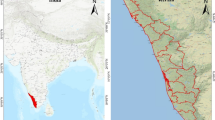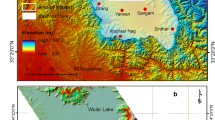Abstract
The spatial distribution of vegetation pattern and vegetation cover fraction (VCF) was quantified with remote sensing data in the Hailiutu River basin, a semiarid area in North China. The moderate resolution imaging spectroradiometer normalized different vegetation index (NDVI) values for 4 years from 2008 to 2011 and field observation data were used to assess the impact of climate factors, landform and depth to water table on vegetation distribution at large scale. In the VCF map, 74 % of the study area is covered with low and low–medium density vegetation, 24 % of the catchment is occupied by medium–high and high-density vegetation, and 2 % of area is bare soil. The relationship between NDVI and climate factors indicated that NDVI is correlated with relative humidity and precipitation. In the river catchment, NDVI increases gradually from landform of sand dune, eolian sand soil to river valley; 92.4 % of low NDVI from 0.15 to 0.3 is mostly distributed in sand dunes and the vegetation type is shrubs. Crops, shrubs and some dry willows dominate in eolian sand soil and 82.5 % of the NDVI varies between 0.2 and 0.35. In the river valley, 70.4 % of NDVI ranges between 0.25 and 0.4, and grass, dry willow and some crops are the main plants. Shrubs development of Korshinsk peashrub and Salix psammophila are dependent on groundwater by analyzing NDVI response to groundwater depth. However, NDVI of Artemisia desertorum had little sensitivity to groundwater.








Similar content being viewed by others
References
Caccamo G, Chisholm LA, Bradstock RA, Puotinen ML (2011) Assessing the sensitivity of MODIS to monitor drought in high biomass ecosystems. Remote Sens Environ 115:2626–2639
Cuo L, Vogler JB, Fox JX (2010) Topographic normalization for improving vegetation classification in a mountainous watershed in Northern Thailand. Int J Remote Sens 31(11):3037–3050
Eamus D, Froend R, Loomes R, Hose G, Murray B (2006) A functional methodology for determining the groundwater regime needed to maintain the health of groundwater-dependent vegetation. Aust J Bot 54:97–114
Friedl MA, Mciver DK, Hodges JCF, Zhang XY, Muchoney D, Strahler AH, Woodcock CE, Gopal S, Schneider A, Cooper A, Baccini A, Gao F, Schaaf C (2002) Global land cover mapping from MODIS: algorithms and early results. Remote Sens Environ 83:287–302
Goedhart CM, Pataki DE (2011) Ecosystem effects of groundwater depth in Owens Valley, California. Ecohydrology 4:458–468
Gutman G, Ignatov A (1998) The derivation of the green vegetation fraction from NOAA/AVHRR data for use in numerical weather prediction models. Int J Remote Sens 19(8):1533–1543
Hu MQ, Mao F, Sun H, Hou YY (2011) Study of normalized difference vegetation index variation and its correlation with climate factors in the three-river-source region. Int J Appl Earth Obs Geoinf 13:24–33
Hwang T, Song C, Bolstad PV, Band LE (2011) Downscaling real-time vegetation dynamics by fusing multi-temporal MODIS and Landsat NDVI in topographically complex terrain. Remote Sens Environ 115:2499–2512
Isaacs EH, Srivastave RM (1989) An introduction to applied geostatistics. Oxford University Press, New York
Jiménez-Muñoz JC, Sobrino JA, Plaza A, Moreno J, Martinez P (2009) Comparison between fractional vegetation cover retrievals from vegetation indices and spectral mixture analysis: case study of PROBA/CHRIS data over an agricultural area. Sensors 9:768–793. doi:10.3390/s90200768
Jin S, Sader SA (2005) MODIS time-series imagery for forest disturbance detection and quantification of patch size effects. Remote Sens Environ 99:462–470
Knight JK, Lunetta RL, Ediriwickrema J, Khorram S (2006) Regional scale land-cover characterization using MODIS-NDVI 250 m multi-temporal imagery: a phenology based approach. GIsci Remote Sens 43:1–23
Le Marie G, Marsden C, Nouvellon Y, Grinand C, Hakamada R, Stape J, Laclau J (2011) MODIS NDVI time-series allow the monitoring of Eucalyptus plantation biomass. Remote Sens Environ 115:2613–2625
Lichner L, Hallett PD, Orfánus T, Czachor H, Rajkai K, Šír M, Tesař M (2010) Vegetation impact on the hydrology of an aeolian sandy soil in a continental climate. Ecohydrology 3:413–420
Lucht W, Prentice LC, Myneni RB, Sitch S, Friedlingstein P, Cramer W, Bousquet P, Buermann W, Smith B (2002) Climatic control of the high-latitude vegetation greening trend and Pinatubo effect. Science 296:1687–1689
Lunetta RS, Knight JF, Ediriwickrema J, Lyon JG, Worthy LD (2006) Land cover change detection using multi-temporal MODIS NDVI data. Remote Sens Environ 105:142–154
Lv JJ, Wang XS, Zhou YX, Qian KJ, Wan L, Eamus D, Tao ZP (2012) Groundwater-dependent distribution of vegetation in Hailiutu River catchment, a semi-arid region in China. Ecohydrology. doi:10.1002/eco.1254
Naumburg E, Mata-Gonzalez R, Hunter RG, Mclendon T, Martin DW (2005) Phreatophytic vegetation and groundwater fluctuations––a review of current research and application of ecosystem response modeling with an emphasis on Great Basin vegetation. Environ Manage 35:726–740
Nemani RR, Keeling CD, Hashimoto H, Jolly WM, Piper SC, Tucker CJ, Myneni RB, Running SW (2003) Climate-driven increases in global terrestrial net primary production from 1982 to 1999. Science 300:1560–1563
Nezlin NP, Kostianoy AG, Li B (2005) Inter-annual variability and interaction of remote-sensed vegetation index and atmospheric precipitation in the Aral Sea region. J Arid Environ 62:677–700
Richards Y, Poccard I (1998) A statistical study of NDVI sensitivity to seasonal and interannual rainfall variations in southern Africa. Int J Remote Sens 19:2907–2920
Roerink GJ, Menenti M, Soepboer W, Su Z (2003) Assessment of climate impact on vegetation dynamics by using remote sensing. Phys Chem Earth 28:103–109
Sakamoto T, Yokozawa M, Toritani H, Shibayama M, Ishitsuka N, Ohno H (2005) A crop phenology detection method using time-series MODIS data. Remote Sens Environ 96:366–374
Stromberg JC, Tiller R, Richter B (1996) Effects of groundwater decline on riparian vegetation of semi-arid regions: the San Pedro River, Arizona, USA. Ecol Appl 6:113–131
Trimble SW (1990) Geomorphic effects of vegetation cover and management: some time and space considerations in prediction of erosion and sediment yield. In: Thornes JB (ed) Vegetation and erosion. Wiley, London, pp 55–66
Wardlow BD, Egbert SL, Kastens JH (2007) Analysis of time-series MODIS 250 m vegetation index data for crop classification in the U.S. central Great Plains. Remote Sens Environ 108:290–310
White AB, Kumar P, Tcheng D (2005) A data mining approach for understanding topographic control on climate-induced inter-annual vegetation variability over the United States. Remote Sens Environ 98:1–20
Wierda A, Fresco LFM, Grootjans AP, van Diggelen R (1997) Numerical assessment of plant species as indicators of the groundwater regime. J Veg Sci 8:707–716
Zeng B, Yang TB (2009) Natural vegetation response to warming climates in Qaidam Basin 1982–2003. Int J Remote Sens 30(21):5685–5701
Zhan X, Defries R, Townshend JRG, Dimiceli C, Hansen M, Huang C, Sohlberg R (2000) The 250 m global land cover change product from the moderate resolution imaging spectroradiometer of NASA’s Earth Observing System. Int J Remote Sens 21:1433–1460
Zhang JY, Dong WJ, Fu CB, Wu LY (2003) The influence of vegetation cover on summer precipitation in China: a statistical analysis of NDVI and climate data. Adv Atmos Sci 20:1002–1006
Acknowledgments
The authors thank the anonymous reviewers who provide insightful and constructive comments and made this paper improved a lot as a result. We are grateful for the financial support from the Asia Facility for China project ‘Partnership for research and education in water and ecosystem interactions’, UNESCO-IHE Institute for Water Education. This study is also supported by the National Natural Science Foundation and Fundamental Research Funds for the Central Universities granted by the Ministry of Education of China.
Author information
Authors and Affiliations
Corresponding author
Rights and permissions
About this article
Cite this article
Jin, X.M., Guo, R.H., Zhang, Q. et al. Response of vegetation pattern to different landform and water-table depth in Hailiutu River basin, Northwestern China. Environ Earth Sci 71, 4889–4898 (2014). https://doi.org/10.1007/s12665-013-2882-1
Received:
Accepted:
Published:
Issue Date:
DOI: https://doi.org/10.1007/s12665-013-2882-1




